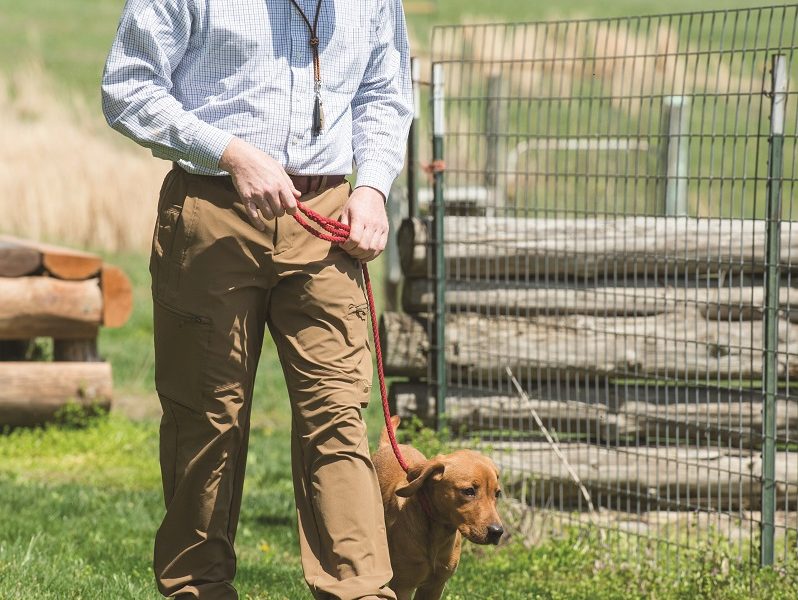Part I
This article continues my discussion of getting a Lab to retrieve without force-fetching, focusing on the final steps – holding the object and delivering it to hand, which completes a formal retrieve. Getting reliable deliveries is the goal achieved by the specialized force-fetch procedure, a technique used most often by hunters and field competitors to get extremely reliable holding of the fetch object and delivery to hand without letting go. Like others, I long argued in favor of force-fetching; it is certainly the best option for most professional trainers. In training many retrievers, however, I’ve recognized that force-fetching does not complete the job. Training that supports proper delivery, both before and after force-fetch, is essential to establishing good lifelong habits; but this “supporting training” can be developed to do the whole job.
As I’ve helped many owners train their own dogs, I’ve seen how challenging force-fetching can be. It is a process that includes many judgment calls: how much force to use, how long to continue a session, when it’s appropriate to add more challenge, whether a refusal is grounds for more force or for simplification, etc. These calls are difficult to make without experience. And of course, many owners are not comfortable systematically pinching their Lab’s ear or toe. Likewise, sending a personal or family pet away for three months or more of professional training is a similarly unattractive option for many owners, especially since this is traditionally begun around six or seven months of age. Owners miss out on their dogs’ late puppyhood.
There is more than one way to accomplish any goal with a dog, and that includes the basics of retrieving. By enhancing the other parts of training that support learning a good retrieve, it is possible, with care and time, to teach your Lab a completely reliable hold and delivery to hand without force-fetching.
Many Lab owners consider a retrieve complete if their dog drops an item at or near their feet. There are, however, plenty of reasons to want a dog to deliver to hand. The obvious application is in hunting, where a live bird will get away if dropped. Other owners may not want to – or perhaps can’t – bend over to pick up the dummy from the ground every retrieve, or they may want the polish of a formal, sitting delivery.
A question worth asking is, “Why is teaching delivery to hand so difficult?” These dogs are retrievers, after all, and clearly have an innate ability to retrieve. While we do not know what a dog is thinking, I can make a couple of educated guesses. There’s evidence that our Labs tend to believe we want them to drop the dummy. The more authoritative we appear, especially if we admonish or correct them, the more likely they are to spit it out. It may be they regard retrieving as play, to be set aside the moment we ask them to respond to a command. Or perhaps they’re eager for the next throw and want to hurry it up. Since the human must have the dummy in order to throw it, many Labs self-teach to spit the dummy toward the handler’s feet as they come back.
Are these explanations correct? I don’t know, but all of the strategies I’ve found to help with delivery are consistent with one, the other, or both. It is probably worth thinking through your training so you minimize or avoid punishment or other authoritarian actions at delivery, and also try not to reward dropping by picking up the dummy and immediately throwing it again. In addition, the advice I’ve given throughout this series continues to apply: Keep retrieving sessions very short. Two or three retrieves are enough for most Labs as they are learning. Remember, when they need to pant, they would rather not have something in their mouths; and when they are no longer fresh, they cut corners and ignore details.
You can probably infer that there is an order in which things need to be taught. Establish the habit of delivery to hand before worrying about sitting to deliver, coming to the heel position to sit and deliver, or other trained details. Banish the phrase “he’s going to have to do it eventually” from your training vocabulary. First things first.
If you ever get to the point where your Lab delivers on some retrieves and not others, you have it made. Simply make a rule: You will throw again only when she delivers to hand. This does not mean you must throw again each time she delivers, extending the session into many retrieves. Once she puts together, however, that delivery to hand might produce another retrieve while dropping never does, she will take responsibility for getting it right.
[dropcap]T[/dropcap]here are three stages of training a Lab to deliver: early, informal training; formal training to hold; and following up in a manner that reinforces the training and makes it reliable. In this installment, I’ll describe the early training that supports delivery to hand; next issue, I’ll discuss teaching the hold command and transitioning to making it work in the field or yard.
In early training, choose a retrieving object your puppy or dog can easily carry and likes to hold. This could be a plush toy or lightweight canvas dummy. Do not panic if your puppy growls and holds on tight, reluctant to give up the object! That is normal puppy behavior they all outgrow. Do delay taking the toy on return, and make a fuss over your puppy or young dog for a few seconds as she holds the toy.
As you pet and praise your puppy or young dog, maneuver her into position facing forward for the next throw without giving any commands. Take the dummy from her mouth and, in as close to the same motion as you can make it, flip it forward for the next retrieve. Try to avoid drama, conflict, or a long delay between the time your Lab gives up the dummy and when you next throw it. Don’t worry about distance of throw, obedience, or anything else. Focus on the pattern you are trying to establish.
If your Lab is already at a more advanced stage of retrieving and is dropping plastic dummies, try going back into the house with a plush toy and try to get retrieves to hand according to this pattern.
When your puppy is teething and if she cannot deliver a plush toy without dropping it, just suspend retrieving until she gets over the tenderness in her mouth. Training will be much easier if she never gets the idea that dropping the object is a viable strategy.
If you do early field work before formally teaching the hold command, choose situations that promote delivery to hand. You have not established any basis for correcting wrong behavior, so concentrate on setting your Lab up to do it right! Keep using a lightweight canvas dummy. For retrieves in the water, consider going into the water yourself so you can take the dummy a step or two after your Lab gets her feet on the solid bottom of the pond. She is unlikely to keep holding it once she is clear of the water and wants to shake. On land, if she runs by you holding the dummy and you can take it from her mouth, that’s great. Do not emphasize a formal finish to the retrieve at this stage.
When you feel your Lab is ready, you can begin training her to hold the dummy on command. I recommend waiting until after you have taught several obedience commands. Prior training equips your Lab with the ability to understand that there is something you expect, and that she can earn praise by doing it. Experience with specific commands sets both of you up for success. It is best if you first train her both to heel and to lie down (and to stand, if you will be teaching her that), as well as to stay in various positions. This training prepares your Lab to more readily accept pieces of the procedure for teaching hold.
Holding the dummy until told to release is an action that has duration. Duration of a command is not the easiest concept for dogs to grasp, so it helps if it has already been established with heeling and staying. In addition, physically placing a dummy in your Lab’s mouth is intrusive. Training down by physically placing her on the ground, and continuing until she accepts the handling without resistance, will help reduce her objection to having her mouth handled and controlled by you.
In addition, her sit needs to be strong. Do not rely solely on corrections to establish a reliable sit. Practicing around distractions with a high rate of success orients your dog to seeking to do what is right rather than fearing to make a mistake. This difference is important when teaching her to hold. As stated before, reminders of your authoritarian status will influence your dog to quickly jettison the dummy, while the expectation that trying something new may lead to your approval will promote quick learning.
Omitting the “force” part of force-fetching places more responsibility on the trainer to get the details correct by taking away the ability to paper over them with force. Concentrate on the early supportive training, and establish obedience based on an attitude of “want to” rather than “afraid not to,” and your Lab will be well-prepared to learn to hold a dummy on command, which will be our subject next time.




